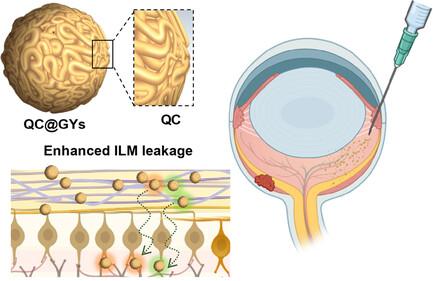Ophthalmic Tethered Gold Yarnball-Mediated Retained Drug Delivery for Eye Fundus Disease Treatment
IF 11.1
Q1 MATERIALS SCIENCE, MULTIDISCIPLINARY
引用次数: 0
Abstract
Eye fundus diseases, such as retinal degenerative diseases, which lead to blindness in ≈12% of individuals aged >65 years, cause permanent damage to retinal cells. The antioxidant quercetin (QC) is promising for the effective treatment of eye fundus diseases; however, its poor solubility and low retention rate often limit its clinical application. Herein, an in situ ophthalmic tethered gold yarnball (GY) that doubles as an ocular retention agent and QC reservoir to overcome low fundus drug retention is developed. After intravitreal injection, QC@GYs enhance retinal cell leakage and internal limiting membrane permeability, facilitating the partial penetration of QC@GYs into the intraretinal tissue. The combination of retina-tethered QC@GY and first-level sustained release reduces macular degeneration in vivo by effectively regulating oxidative stress. Furthermore, the sustained release of QC preserves the viability of retinal pigment epithelium cells, reduces apoptosis, and suppresses drusen formation. This preservation of retinal morphology and function maximizes the therapeutic impact while minimizing the need for frequent intraocular administration. Overall, the ophthalmic tethered GY platform is a versatile tool for retinal drug delivery for the treatment of eye fundus diseases.

用于眼底疾病治疗的眼科系留金纱球介导的留置给药技术
眼底疾病(如视网膜变性疾病)会对视网膜细胞造成永久性损伤,导致 12% 的 65 岁老人失明。抗氧化剂槲皮素(QC)有望有效治疗眼底疾病,但其溶解性差、保留率低,往往限制了其临床应用。在此,我们开发了一种眼科原位系留金纱球(GY),它既是眼部药物保留剂,又是槲皮素储库,可克服眼底药物保留率低的问题。玻璃体内注射后,QC@GYs 可增强视网膜细胞渗漏和内缘膜通透性,促进 QC@GYs 部分渗透至视网膜内组织。视网膜系留 QC@GY 与一级持续释放相结合,可有效调节氧化应激,从而减少体内黄斑变性。此外,QC 的持续释放还能保持视网膜色素上皮细胞的活力,减少细胞凋亡,抑制色素沉着的形成。这种对视网膜形态和功能的保护最大限度地提高了治疗效果,同时将频繁眼内给药的需要降至最低。总之,眼科系留 GY 平台是治疗眼底疾病的视网膜给药多功能工具。
本文章由计算机程序翻译,如有差异,请以英文原文为准。
求助全文
约1分钟内获得全文
求助全文
来源期刊
CiteScore
14.00
自引率
2.40%
发文量
0
期刊介绍:
Small Science is a premium multidisciplinary open access journal dedicated to publishing impactful research from all areas of nanoscience and nanotechnology. It features interdisciplinary original research and focused review articles on relevant topics. The journal covers design, characterization, mechanism, technology, and application of micro-/nanoscale structures and systems in various fields including physics, chemistry, materials science, engineering, environmental science, life science, biology, and medicine. It welcomes innovative interdisciplinary research and its readership includes professionals from academia and industry in fields such as chemistry, physics, materials science, biology, engineering, and environmental and analytical science. Small Science is indexed and abstracted in CAS, DOAJ, Clarivate Analytics, ProQuest Central, Publicly Available Content Database, Science Database, SCOPUS, and Web of Science.

 求助内容:
求助内容: 应助结果提醒方式:
应助结果提醒方式:


